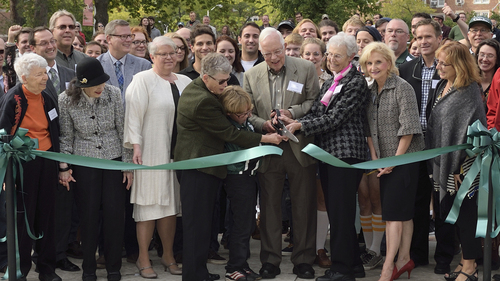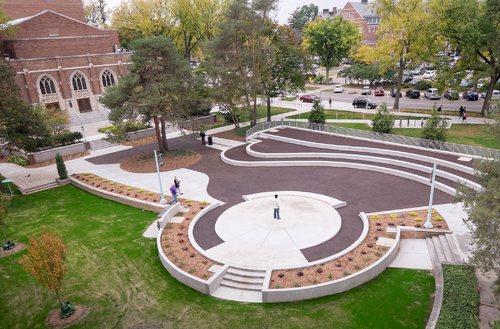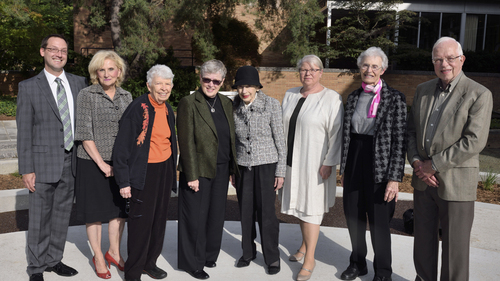
Mission Statement
Summer Circle Theatre (SCT) provides a professional venue for MSU students that offers free theatre to Mid-Michigan audiences. SCT presents shows of varying styles using the talents of community members and professional artists. Beyond theatrical productions, SCT is committed to offering free programming including a Kids Camp and special activities to create a summer destination for arts, education, and entertainment.
A History of Summer Circle Theatre
In the late 1950s, during a period of great growth and reorganization at Michigan State University, Dr. John Dietrich became the chair of the Department of Speech. He made major changes in the theatre program at MSU, creating the Arena Theatre in the basement of the Auditorium Building, increasing the number of plays in Fairchild Theatre, and presenting programs to students and the public on a subscription season ticket basis.
Dr. Dietrich had promised President John Hannah and Dean Gordon Sabine that he would create a summer theatre program at MSU similar to the highly successful Stadium Theatre program he had supervised at Ohio State University. He turned to Frank Rutledge, Edward Andreasen and other members of the faculty, giving them the job of making good on his promise. The university donated Demonstration Hall, a gymnasium formerly used for indoor ROTC drill. Recruiting student help, the team had the daunting task of converting this empty space into a functioning theatre, including installation of seating, lights, a costume shop, a scenery shop, and a lobby.

In 1961 the hard work paid off as Summer Circle Theatre presented its first play, Noel Coward’s Blithe Spirit. The program was a success and Summer Circle Theater, like the OSU program it was modeled after, began presenting five plays each summer to the general public, using students and community actors, and charging admission. Right from the start, SCT operated under the basic premise which still guides it today: to foster collaboration between town and gown using the best talents of both the students and the community to create quality summer theatre.
In 1964, faculty members Rutledge, Andreasen and Brandon took up a new challenge. Dissatisfied with SCT’s arena stage, they decided to redesign it as a three-sided thrust stage with a balcony. That summer, they tested the proposition that any play can be mounted on a thrust stage by mounting productions with widely different requirements, starting with James Thurber’s A Thurber Carnival. The experiment was successful, and SCT continued to present plays in Demonstration Hall until 1969.

In 1968, the Department of Theatre was created within the College of Communication Arts. Professor E.C. Reynolds served as the department’s first chair, with Dr. Herbert Oyer as Dean. The 1968 SCT program experimented again when faculty member John Baldwin received a grant from the Wolfram Foundation to support a company of students to perform in rotating repertory. Six shows were presented on a rotating basis three days a week during the three week summer program, with a show for children presented every morning and a different show for adults presented every night. The company opened with Jules Goodman’s Treasure Island for children and Archibald MacLeish’s J.B. for adults. The following 1969 season, however, consisted of comedies and musicals, apparently to offset the previous summer of “highbrow” repertory theatre.
By April 1970 the Summer Circle Theatre, then a separate entity within the Theatre Department, was bankrupt and a special Provost’s Summer Subsidy was used to pay the indebtedness. At this point, Theatre Department faculty members Frank Rutledge, Gretel Geist and John Baldwin were given the responsibility of deciding the future of SCT. Deciding that bold measures were called for, they moved Summer Circle Theatre outdoors into the Kresge Sculpture Court. Then they went even further. As Frank Rutledge recalled, “since we have no money, we’ll make the plays free; if the plays are free, the public can always leave; if the audience can leave, then we can do whatever we please. Is this the way to attract people?”

Apparently it was. Renamed the Summer Circle Free Festival Theatre and operating with virtually no budget and whatever resources they had at hand, they opened the 1970 summer season with Welcome to the Monkey House, an original adaption of Kurt Vonnegut’s book of short stories. A couple of platforms served as a stage, and people brought folding chairs or sat on the ground. Although advertising consisted mainly of sandwich boards placed along Auditorium Road reading “free theatre tonight,” people attended in droves–so much so that the crowds trampled the petunias in the sculpture court. After two seasons the groundskeepers complained, and, starting with the 1973 season, wooden bleachers were set up to keep the audience out of the flowers.
In 1971, the Department of Theatre was moved to the College of Arts and Letters, which also housed the School of Music and the Department of Art, thus combining all the arts under one administrative umbrella. In 1974, planning began for the Wharton Center for the Performing Arts, with considerable involvement from members of the Theatre Department, including Frank Rutledge. Ideas tested by Summer Circle Theatre’s innovative thrust stage in the 1960s were realized in the design of the Pasant Theater’s stage in the Wharton Center, which opened in 1982.
Meanwhile, the old wooden bleachers in the Kresge courtyard had finally disintegrated and had to be replaced. The new fiberglass bleachers, however, would not fit in the sculpture court, so, after a decade in the courtyard, performances were moved again, this time to the banks of the Red Cedar River. The bleachers were set up on the flood plain facing the river, and the stage backed up to the riverbank. The 1981 season opened in this new location with George Bernard Shaw’s Androcles and the Lion.

During the years in this location, SCT continued to experiment. For a time, three of the season’s plays were recapped by repeating them in rotating repertory for a fourth week. This was abandoned when it proved too onerous. In 1988, two special seminars—one in American dramatic literature and one in American theatre history–were taught jointly during the summer term by the Theatre Department and American Studies. To complement these seminars, SCT changed its focus and its name to become the Summer Circle Free Festival of the American Theatre. This emphasis on American theatre continued through 1994. In 1991, the Dean’s Community Council, gave the program and Frank Rutledge and Gretel Geist its Apollo Award for enhancing the mission of the college in the community.
In 1993, after enduring twelve years in the swampy flood plain plagued with mud, flooding and soggy grass, the stage was moved to higher ground facing the Red Cedar River behind the Auditorium, where it remained through the summer of 2014. Then, deciding that the emphasis on American theatre was too restrictive, the program changed its name back to Summer Circle Theatre. At the same time, the word “free” was dropped to allow the possibility of charging admission in the future.
SCT continued to thrive. In response to a funding crisis in 1995, the Friends of Summer Circle Theatre was formed to help raise funds for SCT and permit the program to survive in a partnership with the Department of Theatre. Although its guiding lights, Frank Rutledge, John Baldwin and Gretel Geist Rutledge are gone, new faculty members and new Department Chairs maintained their commitment and enthusiasm for Summer Circle Theatre. Over 200 plays have been performed over its more than fifty year history and performances annually attract audiences of between three and four thousand people. Despite the challenges inherent in outdoor theatre—including rainstorms and humidity and mosquitoes—SCT remains one of the most successful of all town and gown collaborations.
Today, SCT relies on a combination of funding from the MSU College of Arts and Letters and donations from the community, in a roughly 50-50 split. A community-based organization, Friends of Theatre at MSU, helps raise the community donations. Most of the money raised is used to support student actors and technicians who hone their craft and provide a play-going experience for the community. Community businesses also support SCT: the Granger Corporation, for example, replaced the outdoor stage in 2009 and the MSU Credit Union is a major continuing donor.

In recent years SCT attendance has ranged between 3000-4000 people, depending, of course, on the weather. We don’t have figures for earlier years, but total attendance over the past five decades must approach 150,000. Among the attendees are many young people, who receive an introduction to theatre in a unique setting, and many older citizens for whom these performances are a continuing pleasure.
The MSU Department of Theatre has maintained its commitment to Summer Circle Theatre and its outreach to the Greater Lansing community. Theatre faculty and students join community actors to create a “win-win” experience for the faculty, the students and the entire community.

In celebration of its Fiftieth Anniversary, SCT again presented its very first play, Blithe Spirit, along with others. A Gala celebration, Fifty Golden Years Onstage, was held on the Fairchild Theatre stage in May, 2010. In 2012, Summer Circle Theatre received the City of East Lansing Crystal Award for its dedication to enhancing the East Lansing community by creating a healthy and vibrant community as an inspiration to others.
In 2011, longtime Summer Circle Theatre supporters Sam and Mary Austin suggested to Dr. George Peters, then chairperson of the Department of Theatre, that they would like to see a new permanent home for Summer Circle Theatre and would help to fund it.

On September 18, 2014, the Summer Circle Courtyard was dedicated by MSU’s 20th President, Lou Anna K. Simon. 

(L-R) Kirk A. Domer (Department of Theatre Chairperson), Jacqueline Babcock (Friends of Theatre President), Linda Nelson, Lou Anna K. Simon (MSU President), Selma Hollander, Karin A. Wurst (Former College of Arts and Letters Dean), Mary and Sam
Starting in July 2013, the Department of Theatre and the Friends of Theatre at MSU launched a major fundraising campaign for a permanent home for Summer Circle Theatre. Lead donors Sam and Mary Austin started the process in motion when Sam (former Friends of Theatre President and University Distinguished Professor from the Department of Physics and Astronomy and National Superconducting Cyclotron Laboratory), Department of Theatre Chairperson, Kirk Domer and MSU Landscape Architect, Deb Kinney visited various sites around MSU to find the perfect spot. Not surprisingly the space between the Auditorium Building and the Kresge Art Center (former home of SCT from the 1970s) was identified as the ideal location. The Austins’ leadership inspired several other past faculty to support the project: Gretel Geist Rutledge, former costume faculty and widow of the late Frank Rutledge (co-founders of Summer Circle Theatre); Linda Nelson, retired faculty from the Department of Human Development and Family Studies; Selma Hollander, alumnus of the Department of Art, Art History and Design and widow of the late Stanley Hollander, a faculty member in the College of Business; Jane Vieth Suits (and Alan P. Suits), a faculty member in the Department of History; and the Friends of Theatre at MSU who contributed over $100,000 toward the $1.15 million project.